Rankin/Bass adapted Morrie Turner’s multi-racial comic strip into a landmark animated series and an album with a lot to sing about.

KID POWER
The Original TV Sound Track
A Rankin/Bass Production
Pride (MGM) Records PRD-0010 (12” 33 rpm)
Released in 1972. TV Series Producers: Arthur Rankin. Jr., Jules Bass. TV Series Associate Producer: Basil Cox. Writer: William J. Keenan, based on the Comic Strip “Wee Pals” by Morrie Turner. Developed in Consultation with the Bank Street College of Education. Music Producer/Arrangers: Perry Botkin, Jr., Bob Summers. Underscore: Perry Botkin, Jr. Music Consultant: Mike Curb. Creative Consultant: Charles H. Stern. Engineers: Jim Harris, Jack Hunt, Angel Balastier. Running Time: 32 minutes.
Voices: The Curbstones (Vocal Group); Greg Thomas (Oliver); Charles Kennedy (Nipper); Donald Fullilove (Randy, Diz); Jay Silverheels, Jr. (Rocky); Jeff Thomas (Ralph); April Winchell (Connie); Michele Johnson-Murray (Sybil); Gary Shapiro (Jerry, Wellington); Carey Wong (George).
Kid Power Original Songs: “Kid Power (All the Colors in Your Head)”, Don’t Let the World Go By,” “Uncle Tom,” “Don’t Fake It,” “The Most Beautiful Thing in the World,” “Big Fish,” “Easy Way,” “Real World” by Perry Botkin, Jr. and Jules Bass.
Other Songs: “You’ve Got to Be Carefully Taught” (from South Pacific) by Richard Rodgers and Oscar Hammerstein III; “Everybody’s Got Fingers” (S. Burke/M. Burke/J.F.K. Burke), “He’s Got the Whole World in His Hands,” (Traditional); “The Children’s Marching Song” (Adapted by Malcolm Arnold).
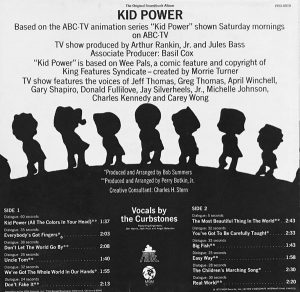 The impact of Sesame Street on television and the social issues of the sixties and early seventies was changing the way people were looking at children’s TV. Almost every show for kids went into some kind of transition on a local and network level. Saturday morning programming was expected to carry some pro-social material in addition to laughs and adventure. The same year Sesame Street premiered, Filmation introduced the first regular African-American cartoon character to Saturday morning with Pete Jones on The Hardy Boys.
The impact of Sesame Street on television and the social issues of the sixties and early seventies was changing the way people were looking at children’s TV. Almost every show for kids went into some kind of transition on a local and network level. Saturday morning programming was expected to carry some pro-social material in addition to laughs and adventure. The same year Sesame Street premiered, Filmation introduced the first regular African-American cartoon character to Saturday morning with Pete Jones on The Hardy Boys.
In September 1970, Hanna-Barbera’s Josie and the Pussycats introduced Valerie, the first female Black animated regular TV character (first appearing in Archie comics in December 1969). Valerie was also the first Black animated regular TV character of any gender whose voice was also played by an African-American—actually two voices. Barbara Pariot portrayed Valerie’s spoken role and her singing voice was Patrice Holloway (co-writer of the hit “You’ve Made Me So Very Happy”).
Then in 1972, Rankin/Bass adapted cartoonist Morrie Turner’s 1965 landmark comic strip Wee Pals for ABC-TV, making Kid Power the first multi-racial network animated series with regular roles cast with actors by their races and ethnicities.
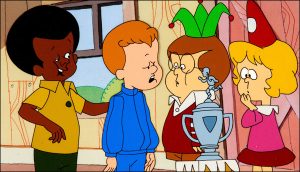 The characters of Randy and Diz were played by Donald Fullilove, who in 1972 was heard speaking as Michael Jackson for the Rankin/Bass animated Jackson 5ive. He later played Goldie Wilson onscreen in the Back to the Future films and performed voices in WALL-E, Up and What If…? Jay Silverheels, Jr., son of the actor who played Tonto in The Lone Ranger films and TV shows, voiced Rocky, a Native American. Charles Kennedy voiced Nipper, the character Morrie Turner fashioned after his young self, much as Charlie Brown was a part of Charles Schulz’s childhood.
The characters of Randy and Diz were played by Donald Fullilove, who in 1972 was heard speaking as Michael Jackson for the Rankin/Bass animated Jackson 5ive. He later played Goldie Wilson onscreen in the Back to the Future films and performed voices in WALL-E, Up and What If…? Jay Silverheels, Jr., son of the actor who played Tonto in The Lone Ranger films and TV shows, voiced Rocky, a Native American. Charles Kennedy voiced Nipper, the character Morrie Turner fashioned after his young self, much as Charlie Brown was a part of Charles Schulz’s childhood.
Cast as feminist Connie was a preteen April Winchell, now one of Hollywood’s top voice actors (as well as a writer and satirist) whose oeuvre includes Who Framed Roger Rabbit and Despicable Me 2. For many years now, Winchell has provided the voice of Clarabelle Cow, a bovine beauty to which we devoted this Animation Spin. Michelle Johnson-Murray (Sybil) later appeared as Tabi on the series Degrassi High. Gary Shapiro (Jerry) was the voice of Jamie in Hanna-Barbera’s Sealab 2020, the same year as Kid Power.
Voicing Oliver, the bespectacled “Charlie Brown-meets-Linus” president of the Rainbow Club is Greg Thomas. His brother Jeff plays the Archie Bunker, Jr.-esque Ralph. Both are familiar voices to frequent Rankin/Bass enthusiasts as Sombertown children in the 1970 classic, Santa Claus is Comin’ to Town. One can practically hear Ralph saying, “That’s the only way they judge you around here. By how many chores you do and how clean your stockings are.”
Even though the series was scripted by William J. Keenan (The Year Without a Santa Claus), excerpts of dialogue (including the series title) and the casual, “neighborhood” tone were taken directly from the original comic strips. The “Peanuts” flavor was by design, as Charles M. Schulz was a friend and mentor of Morrie Turner.
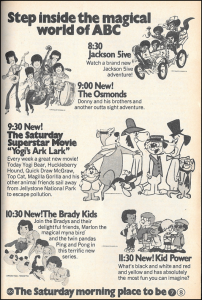 It was Schulz and comedian/activist Dick Gregory who encouraged Turner to create his own African-American comic strip, first entitled Dinky Fellas before it combined races and ethnicities, and was retitled Wee Pals (not unlike Schulz’s original name for Peanuts, “Li’l Folks”). A fascinating, detailed history of Morrie Turner, Wee Pals, and his legacy can be found here in a The Comics Journal article.
It was Schulz and comedian/activist Dick Gregory who encouraged Turner to create his own African-American comic strip, first entitled Dinky Fellas before it combined races and ethnicities, and was retitled Wee Pals (not unlike Schulz’s original name for Peanuts, “Li’l Folks”). A fascinating, detailed history of Morrie Turner, Wee Pals, and his legacy can be found here in a The Comics Journal article.
In its original run, ABC scheduled Kid Power between reruns of Bewitched and reruns of 1971’s The Funky Phantom. It was a curious position since four other brand-new series–Jackson 5ive, The Osmonds, The ABC Saturday Superstar Movie and The Brady Kids–were scheduled before the not-new Bewitched. However, Bewitched was still running in prime time and the reruns were not yet widely seen in syndication. Perhaps the intent was to position the popular sitcom as a strong ratings lead-in for Kid Power.
NBC’s competition against Kid Power was the live-action game show Runaround (hosted by ventriloquist/voice actor/inventor Paul Winchell — and April’s father). Neither network could withstand the CBS powerhouse block of Sabrina the Teen-Age Witch, The Amazing Chan and the Chan Clan, The New Scooby-Doo Movies, The Flintstone Comedy Show, Archie’s TV Funnies, and Fat Albert and the Cosby Kids.
The following season, ABC relegated Kid Power to Sunday mornings (“the cornfield” in Twilight Zone terms), where former Saturday morning reruns were sent if they did not prove strong enough for the fierce Saturday morning competition, or if they had been competing for too many years. Some were in a category by themselves.
Kid Power was followed on Sunday mornings from 1973 to 1974 by The Osmonds, H.R. Pufnstuf, and the beloved live-action docu-montage-fantasy, Make a Wish.
The early seventies was the era of Coca-Cola’s “I’d Like to Teach the World to Sing” advertising campaign and hit song. From the standpoint of recorded music, the Kid Power album is entertaining and important in the Free to Be… You and Me tradition. The hope here was that people would gather as one to share common bonds rather than focusing on divisions.
So it’s all grooviness and puka shells and hanging macramé flower baskets, but the very finest example of the genre. A very lavish album, all the songs were augmented with additional orchestration beyond what was heard on the TV episodes. Many producers were aware that mono TV speakers of the day were not capable of handling complex, elaborate sound, so the music is simpler in the TV songs. Massive string and brass sections were added for the record and the results are magnificent.
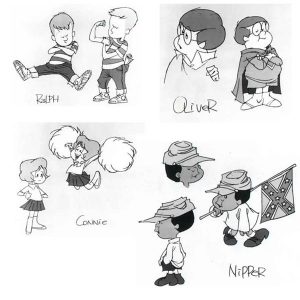 With Rankin/Bass at the busiest time in their history (specials, feature films and TV series on networks and in syndication), Maury Laws was unavailable to score Kid Power, so the talented Perry Botkin, Jr. composed the background cues and co-wrote almost all the songs with series co-producer/director Jules Bass, as in the usual manner of Rankin/Bass specials.
With Rankin/Bass at the busiest time in their history (specials, feature films and TV series on networks and in syndication), Maury Laws was unavailable to score Kid Power, so the talented Perry Botkin, Jr. composed the background cues and co-wrote almost all the songs with series co-producer/director Jules Bass, as in the usual manner of Rankin/Bass specials.
Botkin was a top-notch composer/arranger, most famous for the hit, “Nadia’s Theme (The Young and the Restless)” and Oscar-nominated “Bless the Beasts and the Children” that he wrote with Barry DeVorzon. Many Botkin arrangements are legendary, including José Feliciano’s “Feliz Navidad,” Robin (Jackie) Ward’s “Wonderful Summer,” and The Cascades’ “Rhythm of the Rain.”
Many of the Laws-Bass songs had carried morals and messages in previous scores, so the Bass-Botkin Kid Power songs fit nicely in the Rankin/Bass songbook. One of the best is “Don’t Let the World Go By,” a lesson for all ages about savoring the moment that one could consider a companion piece to the Laws-Bass song, “My World is Beginning Today,”
“The Curbstones” were the children’s ensemble version of Mike Curb Congregation vocal group (“Candy Man”). Curb headed MGM Records at the time and Pride was one of its subsidiary labels.
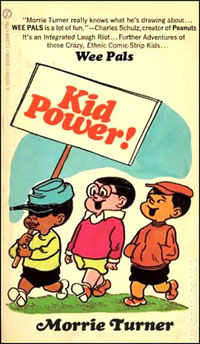 In addition to the Bass and Botkin selections, there are also songs created by other outstanding talents. “Everybody’s Got Fingers” owes its spiritual soul to co-writer Solomon Burke. According to Billboard, the legendary preacher and R&B music pioneer originally recorded it in 1971 with twelve of his children in a group called Sons and Daughters of Solomon. Arranger/producer Bob Summers helmed these songs. Summers’ credits include Sailor Moon, The Life and Times of Grizzly Adams, Miami Vice and The Simpsons (he played trumpet for Bart in the episode “The Kid is All Right”).
In addition to the Bass and Botkin selections, there are also songs created by other outstanding talents. “Everybody’s Got Fingers” owes its spiritual soul to co-writer Solomon Burke. According to Billboard, the legendary preacher and R&B music pioneer originally recorded it in 1971 with twelve of his children in a group called Sons and Daughters of Solomon. Arranger/producer Bob Summers helmed these songs. Summers’ credits include Sailor Moon, The Life and Times of Grizzly Adams, Miami Vice and The Simpsons (he played trumpet for Bart in the episode “The Kid is All Right”).
Of particular note is Summers’ approach to Rodgers and Hammerstein’s “You’ve Got to Be Carefully Taught” from South Pacific. The Kid Power version may be the only one that was done with such a surprisingly antithetical arrangement. (The song itself is a rather potent choice for a children’s album and TV series to begin with.)
Intended to be performed in a bitter state of resentful bile (as Harry Connick demonstrated in 2001), Hammerstein’s thought-provoking and historically controversial lyrics strike out at the demons existing within one’s mind as a result of being “taught to hate all the people your relatives hate.” Imagine hearing those lyrics sung by a children’s chorus set to a jubilant, bouncy dance beat glittering with bells, more akin to a Christmas party tune by The Ventures! Perhaps those “relatives” weren’t supposed to realize what “those waste-of-time cartoons” and “worthless baby records” were singing at the top of their lungs.
Kid Power was born of the explosive previous decade of the sixties that inspired efforts to find ways to build bridges, find mutual understanding and somehow forge bonds in the seventies. Both the album and the series made the finest effort possible within the limits of the era and the production circumstances, and they most certainly made entertainment history.
Kid Power Original TV Soundtrack Album
Each selection begins with a snippet of soundtrack dialogue with underscore music by Perry Botkin, Jr. (usually an instrumental version of one of the songs). It’s a nice way to convey the overall flavor of the show without restricting the album to a few stories and fewer songs.
A very small portion of this feature was previously posted.


 GREG EHRBAR is a freelance writer/producer for television, advertising, books, theme parks and stage. Greg has worked on content for such studios as Disney, Warner and Universal, with some of Hollywood’s biggest stars. His numerous books include Mouse Tracks: The Story of Walt Disney Records (with Tim Hollis). Visit
GREG EHRBAR is a freelance writer/producer for television, advertising, books, theme parks and stage. Greg has worked on content for such studios as Disney, Warner and Universal, with some of Hollywood’s biggest stars. His numerous books include Mouse Tracks: The Story of Walt Disney Records (with Tim Hollis). Visit 






















































I never saw Kid Power — I had Confirmation class on Saturday mornings that year — but I enjoyed the “Wee Pals” comic strip in the newspaper. 1972 also marked the debut of “The Most Important Person”, a syndicated animated series from John Sutherland Productions with a cast of ethnically diverse children (as well as a bird, a dodo, and some hairy Cousin Itt-looking thing). To my knowledge it never had a tie-in record album, which is a shame, because the show had some catchy and memorable songs. “Oops, you made a mistake, that’s all! And making mistakes is never fun!”
You consistently produce outstanding columns filled with information I didn’t know so, once again, “thank you”! The 1970s were filled with an overflowing of great cartoon shows on Saturday mornings so it was easy for some shows to get lost in the flood. I definitely appreciate you sharing your musical expertise with us in your columns as well so I get a better understanding and perspective.
Maybe one of these days you might consider doing a column on what it was like writing Disney comic books based on Disney animated features and the challenges and surprises you faced. You could always do it as an “extra” column for Jerry who is always looking for “extras” which is one of the reasons I sometimes pop up on a Monday as well as a Friday. Of course, I’d love for some of the readers of this site like Scott Shaw! or Jim Engel or others to do an occasional “extra” column as well.
I remember seeing “Kid Power” and enjoying the songs. “There was a big fish… oh yeah…” Had a cassette recorder and taped them off the TV. And I loved “Make a Wish” with Tom Chapin (Harry’s brother)!
The “Young and the Restless” theme was originally composed as part of the “Bless the Beasts and Children” score.
Nice looking show. Just wish there wasn’t a laugh track. There’s a reason why Schulz never used one in any of the animation adaption of his comic strip.
A good reason. He could tell the network he didn’t want one. He was Charles Schulz.
A friend of mine tells me that while doing some research on the WEE PALS comic strip, he ran into some grumbling (back in ’73 and ’74) that ABC had had no faith in the KID POWER television series and had deliberately sabotaged its chances for success by giving it a poor time-slot on Saturday mornings, and then dumping it to Sundays.
I don’t remember seeing it on Saturday mornings, but my Saturdays were frequently pre-occupied with baseball and my father’s dreams of having a son who was a major leaguer. (He didn’t get one.) Also, a look at old TV schedules reveals that it was on opposite the second half of THE FLINTSTONES COMEDY HOUR, and I do remember quite clearly my sister insisting on watching that. She was, at the time, a devotee of all things Flintstone.
I do remember seeing it on Sundays, killing time in front of the set before we left for mass.
I was aware of the comic strip through paperback collections of it, though it never ran in our local paper. The features editor seemed to have a distrust of any comic strip that didn’t predate 1950.
Interestingly, KID POWER’S ‘second season’ on ABC’s 1973-74 Sunday AM schedule did have a limited number of new episodes. In the 1970s, that privilege was restricted to Saturday AM shows that were deemed big enough hits. The show would continue to air on Saturday with six or eight new episodes that would be followed by repeats of the 13-16 episodes from the first season. SCOOBY-DOO, HARLEM GLOBETROTTERS, JACKSON 5IVE, BRADY KIDS, EMERGENCY PLUS 4, STAR TREK and the ALL-NEW POPEYE HOUR are examples. That’s the only example I can think of a show relegated to the Sunday morning graveyard with new episodes.
Ah, the good old ’70s, when it was about power and not perpetual victimhood. And “Song of the South” played two successful theatrical engagements without people shrieking about the horror of it all.
It’s funny that some elements of this show would not be “PC” today! I loved the show, remember it moving to Sunday mornings and glad for that (instead of disappearing altogether). The theme’s “red, yellow, black and white”… I don’t think anyone considers it proper anymore to refer to yellow or red skin. Most curious is little Nipper… most probably wouldn’t have gone with that name… with his love of the Confederacy, his matching hat and flag and dog named General Lee… I wondered if this article would address that. Still for its time, an important, educational AND entertaining show.
A few things are being tossed around here that might misinform people, especially Nipper of all people “loving the Confederacy.” I don’t think that was Morrie Turner’s intent at all, considering who he was and what he accomplished.
The article in The Comics Journal about Turner does address all those things you mentioned. This post is about the show and the album but I think the experts on the matters you mention can explain them best in that article by people who knew Morrie Turner best.
I agree that the show probably couldn’t run today because viewers would immediately zero in on things like that and, without the article I have linked to to explain it, jump to any number of conclusions.
What might be more important about Kid Power isn’t whether it works “now” but whether it reached out to children “then” and to consider how its philosophy of unity might work “now.”
You will find that link in paragraph eight. There are several other accounts of Turner’s story on the web as well. Hope this is helpful!
There’s nothing curious about Nipper’s Confederate headwear. In the early ’70s, people in the counterculture often wore military gear that they purchased for cheap at war surplus stores. It was a way of turning the tables on the establishment. Likewise, by naming his dog “General Lee”, Nipper becomes General Lee’s master. In both cases, he’s asserting power — Kid Power! Right on!
The show was indeed trapped in a poor time slot, and the juggernaut CBS schedule of the day made short work of “Kid Power.” I’m not sure that I would ever have seen the show in the first place if ABC hadn’t previewed it in prime time in late August of ’72.
That infectious Botkin/Rankin main theme — “KID POWER!!!” — still runs through my mind from time to time.
I admired Turner’s clever strip — for those curious about the feature, I would definitely recommend the excellent R.C. Harvey Comics Journal article cited above — and thought that the show was imaginative and a well thought-out adaptation of the comic strip. It put more of Turner’s work on screen than I thought it would.
Since the network did preview the show in prime time (I think they aired the pilot), John J. O’Connor reviewed it for The New York Times. His comments are kinda interesting:
“‘Kid Power’ is based on the Morrie Turner comic strip. ‘Wee Pals,’ and is produced and directed by Arthur Rankin Jr. and Jules Bass. In the cast are 11 neighborhood kids, each of a different ethnic, religious or racial background. If nothing else, the series must represent the TV ultimate in quota systems.
Battling prejudice and intolerance, the kids reject concepts of ‘black power’ or “white power’ in favor of ‘rainbow power’ — that is, kid power. The sentiments are unassailable, the cartoon kids are adorable, the special musical numbers are bright and bouncy. Another interesting element is the implicit rejection of nonviolence.
One kid, Ralph, is the gang bully and bigot. The other kids try to persuade him otherwise, but Ralph keeps knocking fragile heads. Finally, two of the “good” kids beat up Ralph. In the sturdy tradition of an eye for an eye, that works. As one of the kids observes on a different matter, ‘you’ve got to be taught.'”
It was mentioned here in a previous post (https://cartoonresearch.com/index.php/the-japanese-studios-of-rankinbass/) , but this was the first project that was handled by the Japanese studio Topcraft, which would eventually produce the first Studio Ghibli film Nausicaa Of The Valley Of The Wind.
“It [Topcraft] was founded in February of 1972 by ex-staff members of Toei Doga, including president Toru Hara. After meeting with Arthur Rankin Jr., they got their first job animating ‘Kid Power’, based on a ‘Wee Pals’ newspaper comics strip by Morrie Turner (1923-2014). Directors assigned on the show included Katsuhisa Yamada and Tokiji Kaburaki, with Tsuguyuki Kubo as the supervising director. They would also complete three episodes of ‘The Jackson 5ive’ show, which was otherwise done by Halas & Batchelor in England and Pegbar Productions in Spain”
I faintly remember an episode — the first? — where Nipper wore the hat and named his dog General Lee to show his enthusiasm for the idea of having slaves to do his chores (as opposed to the strip, where he simply didn’t know any history). Then it was explained to him that it was a raw deal for the slaves, and he would have been the slav-ee instead of the slav-er. Nipper ended up keeping the hat and the dog’s name, saying something close to what Turner wrote for him in the strip.
Also recall an episode where one of the girls became president of their club, and began snobbily kicking people out for trivial (non-racial) reasons until she was effectively the outsider. All the kids she banished simply got back together somewhere else.
Unfortunately, at this time we can only go by memory for that episode. Kid Power is the sort of series that, if it were reissued, could only be released on an archival label, like Kino Classics because it is historically significant but not necessarily reflective of how all may have been expressing themselves today. It’s no longer a mainstream children’s show, though kids could watch it given the proper context just as the “Old School” Sesame Street shows have been designated as such, but are still accessible as they are vitally important.
The hat and the dog are symbols, and symbols may send an unintended message outside their context or era. No one involved with Kid Power was advocating the confederacy or slavery.
The major point of this whole post was to recognize what a breakthrough Wee Pals and Kid Power was to popular culture.
So here is the section from The Comics Journal about the hat:
“Morrie pondered: what if Charlie Brown were Black? And what if the cap were a Confederate cap? ‘Now that,’ wrote Tom Carter in the Cartoon Club Newsletter, ‘was indeed a laugh—a child so naive he could sweep away generations of ill will with one innocent, ironic gesture.’
“‘That set everything in motion,’ Morrie said.
“He began thinking about a black Peanuts. He created Nipper, the black kid with the Confederate cap. ‘Nipper was named after the comedian Nipsey Russell,’ Morrie said, ‘—but Nipper was me.’”
The article later says:
“Soon after Wee Pals achieved wider national circulation, {Paul Vitello of The New York Times] reported, Morrie got an angry letter from a reader about Nipper and his Confederate hat: “No self-respecting black person would wear such a hat,’ the writer said, suggesting that Morrie ‘get to know some black people.’
Said Morrie: ‘I wrote back and told the person that I happen to know two black people—my mother and my father.’
“So what about the Confederate hat, an interviewer wanted to know.
“Morrie paused, considering the question, and then replied: ‘Forgiveness.’
‘He was always looking for a teaching moment,’ said Andrew Farago, curator of the Comic Art Museum in San Francisco.”‘
There’s multiple Rankin/Bass TV series I wish could be restored and released to DVD and/or Blu-ray in complete series form; pretty much every TV show they ever made aside from Jackson 5ive, Thundercats and Silverhawks; those already have series sets out, but not stuff like The New Adventures of Pinocchio, Tales of the Wizard of Oz, King Kong, Smokey Bear, Tomfoolery, Reluctant Dragon and Mr. Toad, The Osmonds, Kid Power, Festival of Family Classics, or The Comic Strip. And that isn’t even covering the amount of TV specials and feature films they’ve done that still don’t have proper releases. Shows that either have only a handful of episodes available on DVD, or only exist through bad quality tape bootlegs. These need to be scanned, restored and archived soon before they rot away for good. If not for the boomers that enjoyed them in decades past, then for future generations to look back on and see how the company evolved.
After watching the show, I purchased some of the paperback collections. Ralph didn’t even appear in the strip at first, and there was a Mexican kid called Paul who wasn’t in the cartoon. Maybe ABC or Rankin-Bass thought the show already had too many characters, or they couldn’t find a Mexican child actor to provide Paul’s voice. Viewing the three episodes available on YouTube nearly 50 years later, I was surprised how edgy some of the humor was for Saturday morning child’s fare. When Diz gets flour dumped on him, Randy calls him “Whitey”. George takes offense at someone commenting how there’s a “chink in the machinery”.
It would not do justice to Kid Power or Wee Pals to let this page end with an episode quoted out of context, outside of its story, its time, and its purpose. It is instead its historical significance that I have been making every effort to communicate. The series is not “mainstream” now, but it is extremely relevant now as a major breakthrough because of what it did, when it did it, and that is was first.
In 1972, Rankin/Bass adapted cartoonist Morrie Turner’s 1965 landmark comic strip Wee Pals for ABC-TV, making Kid Power the first multi-racial network animated series with regular roles cast with actors by their races and ethnicities.
Kid Power is the sort of series that, if it were reissued, could only be released on an archival label, like Kino Classics because it is historically significant but not necessarily reflective of how all may have been expressing themselves today. It’s no longer a mainstream children’s show, though kids could watch it given the proper context just as the “Old School” Sesame Street shows have been designated as such, but are still accessible as they are vitally important.
The major point of this post was to recognize what a breakthrough Wee Pals and Kid Power was for popular culture. It was a landmark effort in bridging, communicating, healing and helping children understand and appreciate each other.
The Sons & Daughters of Solomon consisted of 6 of Solomon Burke’s blood children two of Solomon stepchildren. The son used was sung by the Curb Tones who did the original soundtrack for the Kid Power Cartoon. The writers of the song used in the first episode was written by Burke and two of the minor children ( Melanie and John Burke) who was a part of the sibling group that originally record the song “Everybody’s Got Fingers” in 1970 on MGM records.